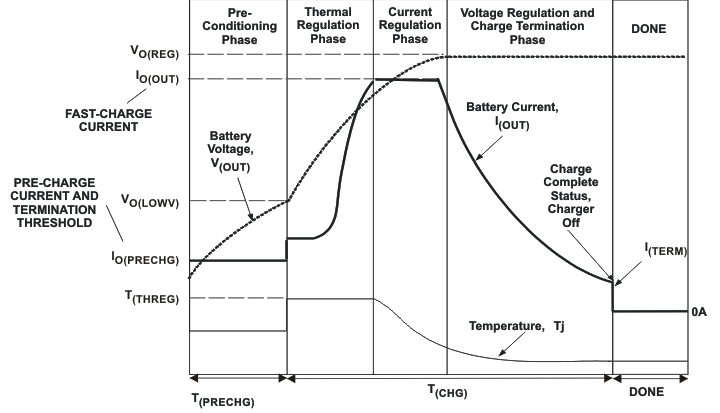JAJSL87H january 2010 – april 2021 BQ24090 , BQ24091 , BQ24092 , BQ24093 , BQ24095
PRODUCTION DATA
- 1
- 1 特長
- 2 アプリケーション
- 3 概要
- 4 Revision History
- 5 概要 (続き)
- 6 Device Options
- 7 Pin Configuration and Functions
-
8 Specifications
- 8.1 Absolute Maximum Ratings #GUID-9FC6FB05-10A6-4323-9A52-EE32AE4C5F67/SLUS9405873
- 8.2 ESD Ratings
- 8.3 Recommended Operating Conditions #GUID-4D70561B-CB71-403D-B731-8EF5DEBEBDF9/SLUS9401392
- 8.4 Thermal Information
- 8.5 Dissipation Ratings #GUID-196940BE-C3C2-4CDF-A8A4-7C186292F803/SLUS9404025 #GUID-196940BE-C3C2-4CDF-A8A4-7C186292F803/SLUS9403553
- 8.6 Electrical Characteristics
- 8.7 Typical Characteristics
-
9 Detailed Description
- 9.1 Overview
- 9.2 Functional Block Diagram
- 9.3
Feature Description
- 9.3.1 Power Down or Undervoltage Lockout (UVLO)
- 9.3.2 UVLO
- 9.3.3 Power Up
- 9.3.4 Sleep Mode
- 9.3.5 New Charge Cycle
- 9.3.6 Overvoltage Protection (OVP) – Continuously Monitored
- 9.3.7 Power Good Indication ( PG)
- 9.3.8 CHG Pin Indication
- 9.3.9 CHG and PG LED Pullup Source
- 9.3.10 IN-DPM (VIN-DPM or IN–DPM)
- 9.3.11 OUT
- 9.3.12 ISET
- 9.3.13 PRE_TERM – Precharge and Termination Programmable Threshold
- 9.3.14 ISET2
- 9.3.15 TS
- 9.4 Device Functional Modes
- 10Application and Implementation
- 11Power Supply Recommendations
- 12Layout
- 13Device and Documentation Support
- Mechanical, Packaging, and Orderable Information
パッケージ・オプション
メカニカル・データ(パッケージ|ピン)
- DGQ|10
サーマルパッド・メカニカル・データ
- DGQ|10
発注情報
9.1 Overview
The BQ2409x is a highly-integrated family of single cell Li-ion and Li-pol chargers. The charger can be used to charge a battery, power a system or both. The charger has three phases of charging: Precharge to recover a fully discharged battery, fast-charge constant current to supply the buck charge safely and voltage regulation to safely reach full capacity. The charger is very flexible, allowing programming of the fast-charge current and Precharge/Termination Current. This charger is designed to work with a USB connection or Adaptor (DC out). The charger also checks to see if a battery is present.
The charger also comes with a full set of safety features: JEITA temperature standard, overvoltage protection, DPM-IN, safety timers, and ISET short protection. All of these features and more are described in detail below.
The charger is designed for a single power path from the input to the output to charge a single cell Li-ion or Li-pol battery pack. Upon application of a 5-V DC power source the ISET and OUT short checks are performed to assure a proper charge cycle.
If the battery voltage is below the LOWV threshold, the battery is considered discharged and a preconditioning cycle begins. The amount of precharge current can be programmed using the PRE-TERM pin which programs a percent of fast charge current (10 to 100%) as the precharge current. This feature is useful when the system load is connected across the battery stealing the battery current. The precharge current can be set higher to account for the system loading while allowing the battery to be properly conditioned. The PRE-TERM pin is a dual function pin which sets the precharge current level and the termination threshold level. The termination "current threshold" is always half of the precharge programmed current level.
Once the battery voltage has charged to the VLOWV threshold, fast charge is initiated and the fast-charge current is applied. The fast-charge constant current is programmed using the ISET pin. The constant current provides the bulk of the charge. Power dissipation in the IC is greatest in fast charge with a lower battery voltage. If the IC reaches 125°C the IC enters thermal regulation, slows the timer clock by half and reduce the charge current as needed to keep the temperature from rising any further. Figure 9-1 shows the charging profile with thermal regulation. Typically under normal operating conditions, the junction temperature of the IC is less than 125°C and thermal regulation is not entered.
Once the cell has charged to the regulation voltage the voltage loop takes control and holds the battery at the regulation voltage until the current tapers to the termination threshold. The termination can be disabled if desired. The CHG pin is low (LED on) during the first charge cycle only and turns off once the termination threshold is reached, regardless if termination, for charge current, is enabled or disabled.
Further details are mentioned in .Section 9.3.
 Figure 9-1 Charging Profile with
Thermal Regulation
Figure 9-1 Charging Profile with
Thermal Regulation